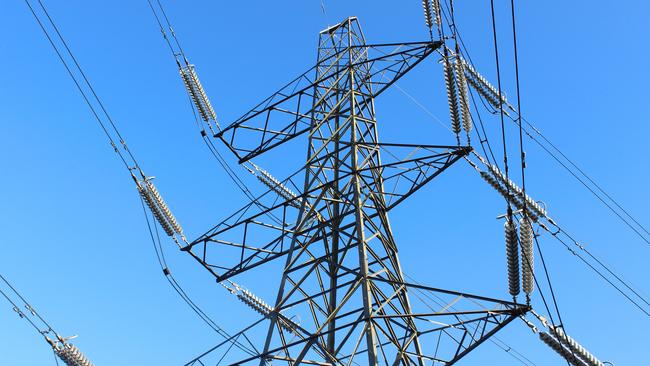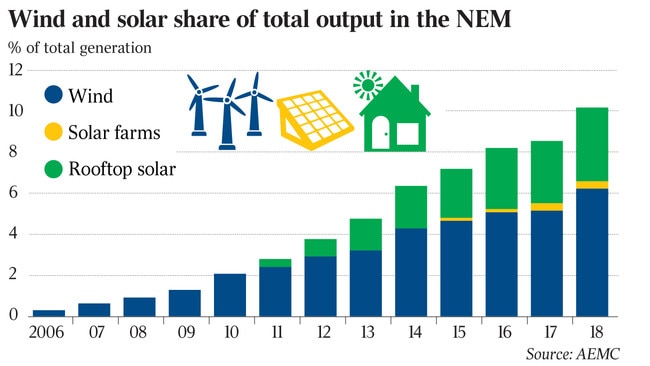Renewable energy puts national power grid under stress
The nation’s electricity grid is relying on emergency safety nets to keep the lights on, regulator warns.

Australia’s electricity grid is relying on emergency safety nets to keep the lights on, amid revelations the energy market operator stepped in more than 100 times last year to order South Australia’s gas generators to provide supply.
This has prompted the nation’s energy rule maker to launch an investigation as the transition to renewables from coal ratchets up costs and places “extraordinary pressures” on the power system.
SA’s electricity system is increasingly operating under the direct intervention of the grid operator, with last-ditch interventions reserved for emergencies becoming a default way of managing the network, as slabs of solar generation test the system’s strength, the Australian Energy Market Commission will warn today.
The deterioration of the strength of the electricity network — most pronounced in South Australia — is also spreading to southwest NSW, northwest Victoria and north Queensland, adding to wholesale costs incurred by users.
“The power system is experiencing more stress as it transitions to more renewables,” AEMC chief executive Anne Pearson writes in The Australian today.
“Systems with lots of non-synchronous generation like wind and solar are weaker and harder to control — raising the risk of cascading blackouts. Unprecedented in their breadth and scope, these trends put extraordinary pressure on the security and reliability of our power grid.” Investment in large-scale renewable energy doubled in 2018 to $20 billion, with one in five Australians now owning rooftop solar and electricity generated by clean energy accounting for 21 per cent of the overall power mix, Clean Energy Council data will show today.
But the unprecedented surge in renewables has also upended the nation’s transmission system, much of which is decades old and was largely designed to cater for coal, which still supplies about 70 per cent of electricity in the system.
Now thousands of smaller generators, including variable renewable supply, are connected to the grid, raising new pressures on the grid operator to ensure voltage and frequency — the nuts and bolts of a power system — are maintained to keep the lights on.
The exit in 2017 of the Hazelwood coal-fired power plant in Victoria has contributed to network issues and unstable voltage in the state, while the impending retirement of facilities like AGL Energy’s Liddell unit in NSW also loom as pressure points for the system.
“The grid is holding up but only because the system operator is intervening on a daily basis to keep the lights on,” Ms Pearson said. “It’s a power system under increasing pressure.”
South Australia required 100 separate interventions in the 2017-18 year for gas generators to provide supply and keep its system stable, compared with just eight in the previous year, Australian Energy Market Operator data provided to the AEMC shows.
It appears to be a trend picking up pace, with South Australia’s generators in total receiving 210 directions since June 30, 2017, a number which the AEMC describes as an “unprecedented use of this intervention mechanism”. And for the first time last year, a Victorian generator was ordered to keep the lights on.
That trend is also pressuring wholesale market prices, with the cost of keeping the system stable soaring to $270 million as of September 2018, while the cost of maintaining frequency control surged nearly tenfold to $220m in 2018 from $25m in 2012.
The Reliability and Emergency Reserve Trader was also used twice, at a cost of $52m, in 2017-18 after never having been activated before — with costs paid by Victorian and South Australian businesses.
“In the face of unprecedented change we see the power system still meeting consumers’ needs but only because the market operator, AEMO, is using the power system’s built-in safety-nets on a daily basis to keep the lights on,” the AEMC says.
“The system’s emergency mechanisms are working well to help AEMO keep the lights on. However these safety nets will not deliver targeted, least-cost solutions to the challenges we are seeing. These emergency, expensive ‘stopgap’ measures are not meant to be used all the time.”
The AEMC said its findings have prompted it to undertake an extensive investigation of intervention mechanisms and system strength.
“In the short term, the aim is to minimise the cost of directions and support lower-cost alternatives,” the AEMC says in its annual market performance review released today.
The AEMC’s warnings underline the fast-changing nature of the grid, but may also be seized upon by political leaders as proof that more needs to be done to ensure the reliability and integrity of the electricity system.
The Coalition has made lower power prices and system reliability two of the central planks of its energy policy in the lead-up to a May federal election, while Labor has pledged to deliver 50 per cent renewables in the nation’s power mix by 2030.



To join the conversation, please log in. Don't have an account? Register
Join the conversation, you are commenting as Logout